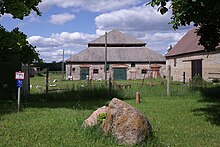Grimschleben
|
Grimschleben
City of Nienburg (Saale)
Coordinates: 51 ° 49 ′ 54 ″ N , 11 ° 47 ′ 11 ″ E
|
|
|---|---|
| Height : | 65 m |
| Residents : | 195 (Feb. 1, 2011) |
| Incorporation : | July 1, 1950 |
| Postal code : | 06429 |
| Area code : | 034721 |
|
Location of Grimschleben in Nienburg (Saale)
|
|

Grimschleben is a district of the city of Nienburg (Saale) in the Salzlandkreis of the German state Saxony-Anhalt .
geography
Geographical location
Grimschleben is located northeast of Bernburg (Saale) on the Saale opposite the mouth of the Bode , which is indicated by the Old Sorbian name of the place Budizko after the river name Buda . The place belongs to the city of Nienburg (Saale) .
history
On April 17, 978, a deed of donation from Otto II said about Grimschleben: the "once Slavic Budisco, but now German Grimerlovo." According to this source there was a Gau or Untergau Grimschleben (Sorbian Budizko), to the 30 Sorbian villages belonged and which joined the Gau Nudzici just north .
The previously important church of Budizko became a subsidiary church under the aegis of the Nienburg monastery, but was again given the status of a parish church in 1258, the pastor of which was mentioned until 1332.
A Dietrich von Grimschleben appeared several times in documents from 1230 to 1235. This noble family based in Grimschleben died out after Johann Christoph Bekmann in 1632.
Not long after 1332, the old Slavic settlement fell into desolation, and Grimschleben became a monastic farm. After the secularization of the monastery in May 1563, this outwork came to the Ascanians, who transformed it into a princely office and leased it.
During the Thirty Years War , Quartermaster Freyberg invaded Grimschleben and the neighboring Borgesdorf in 1630 .
In 1833 Heinrich Lindner described the place as a “ducal domain with a strong sheep farm not far from the Saale, a little higher than the neighboring floodplain.” He also mentions the “traces of the Swedish camp (from 1644), ... a strong wall, or rather a mountain , consistently of fertile soil, which is gradually removed to improve the fields. ”At this point, the Vorwerk is part of the parish of St. Johanni Nienburg.
On July 1, 1950, Grimschleben was incorporated into Nienburg (Saale).
Web links
Individual evidence
- ↑ [1]
- ↑ Ernst Eichler : Slavic place names between Saale and Neisse. Volume I, Domowina-Verlag, Bautzen 1985, p. 68
- ↑ RI II, 2 n. 765 of April 17, 978: “XXX regales mansos in locis subnotatis donamus, in castello scilicet quodam Sclavonice quondam Budizco, nunc autem Theutonice Grimmerslovo, Prudua, Luitatizic, Popouuizic in pago Grimmesilicaitis legalmonitis in comitat determinandos ”, in: Regesta Imperii Online (accessed March 5, 2015).
- ^ Heinrich Lindner: History and Description of the State of Anhalt , Verlag Ackermann, Dessau 1833, p. 601 f
- ↑ Grimschleben.info (accessed March 5, 2015)
- ↑ History of the Principality of Anhalt , 7 parts. Zerbst 1710; Supplementary volume udT Accessiones . Zerbst 1716 (Ndr. Dessau 1995)
- ↑ Erich Vogel: Chronicle of the Nienburg Monastery, Part 2 1004 to 1563 (brochure of the Evangelical Church Congregation St. Johannis and St. Marien and Catholic Church Congregation St. Nicolaus), Nienburg / Saale
- ↑ Landeshauptarchiv Sachsen-Anhalt, Z 70, C 16c 1 Nr. 38 (place of use: Dessau), registration signature: II.H.XXVII.15, film signature: 2273, no digital copy available (accessed on March 5, 2015)
- ^ Heinrich Lindner: History and Description of the State of Anhalt , Verlag Ackermann, Dessau 1833, p. 599 f


